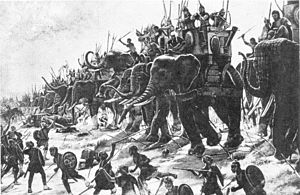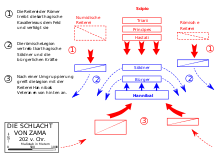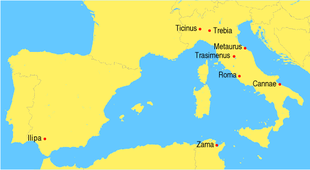Battle of Zama
36.298899.4491667Coordinates: 36° 17′ 56″ N, 9° 26′ 57″ E
Battle of Zama
Part of: Second Punic War

Battle of ZamaPainting
by Henri-Paul Motte
Second Punic War (218-201 BC)
Saguntum - Lilybaeum II - Rhone - Ticinus - Trebia - Cissa - Lake Trasimeno - Ager Falernus - Geronium - Cannae - Nola I - Nola II - Ibera - Cornus - Nola III - Beneventum I - Syracuse - Tarentum I - Capua I - Beneventum II - Silarus - Herdonia I - Upper Baetis - Capua II - Herdonia II - Numistro - Asculum - Tarentum II - New Carthage - Baecula - Grumentum - Metaurus - Ilipa - Crotona - Great Fields - Cirta - Zama
The Battle of Zama took place in 202 BC and was the largest battle in North Africa during the Second Punic War. The Carthaginian Hannibal was fighting the Vth and VIth legions of the Roman commander Cornelius Scipio when they clashed at Zama.
Previous story
After the lost battle on the Great Fields, the Carthaginians had to make a peace that was humiliating for them, the conditions of which included the recall of Hannibal and Magos from Italy. Hannibal landed at Leptis Minor with about 15,000 men, 8000 of whom were veterans of many years of campaigning in Italy. Mago's forces joined him shortly after, Mago himself having died during the crossing.
After Hannibal returned from Italy, the Carthaginians wanted to improve the harsh peace terms that were in the room. Soon an incident occurred that exacerbated the crisis: A convoy of Roman supply ships intended to supply Scipio's army was wrecked in Carthage Bay. Under pressure from the populace, who feared famine after the ravages of war, the Carthaginian Senate decided to seize the ships. When Scipio's emissaries protested this measure, they were insulted and rebuffed.
Both army leaders spent most of the summer of 202 BC gathering their forces. Hannibal sent negotiators to Scipio's camp. The latter did not respond, but allowed the Carthaginians - quite unusually - to move freely around the Roman camp. In doing so, they noticed that Scipio had very little cavalry at his disposal. Hannibal therefore decided to fight, unaware that Scipio knew of the imminent arrival of the Numidian prince Massinissa with 4000 mounted men. Massinissa had fought on Hannibal's side at the beginning of the war, but had changed sides because of the marriage of his rival Syphax with Sophonisbe, a daughter of Hannibal's general Hasdrubal, who had actually been promised to him. Thus it came to the battle of Zama.
Immediately before the battle began, Hannibal and Scipio met in person between the armies. Hannibal offered Scipio a peace, the terms of which would have been much more favourable to Carthage than those agreed upon a year before. Scipio did not go for it, especially as he was determined to punish Carthage for breaking the truce. So the army commanders returned to their troops to let the weapons do the talking.
Course of the battle
Zama marked a turning point in the battles of the Punic War in that the Romans for the first time fielded the smaller infantry, outnumbering the Carthaginians in cavalry with 6000 against 3000. In the front line Hannibal deployed some 40 war elephants, though they were still very poorly trained. The infantry was staggered in three meetings. The veterans rescued from Italy (essentially Libyan spearmen and brutes as well as Gauls) formed the last line and were to bring about the real decision after the first two lines had left the Roman legionaries in disarray and exhausted.
The battle was opened by Scipio with a surprise manoeuvre: Of his legions, drawn up as usual in checkerboard patterns, every other maniple was shifted to one side, so that clear lanes formed between the Romans orthogonal to the battle line, through which most of the war elephants, startled by loud noises from the Romans, passed without doing much damage. On the flanks, however, many elephants sought the path of least resistance through their own cavalry, so that the Carthaginian rather than the Roman line became somewhat disordered.
After extended preliminary skirmishes between Roman light infantry and Hannibal's mix of light infantry and war elephants, the main forces met.
The Roman cavalry could very quickly gain the upper hand over their opponents and then pursued them, rather than re-engaging in the central action and exploiting the advantage of superiority in this branch of arms.
In infantry combat, Hannibal put his opponents under intense pressure. Although his first and second lines of battle broke, this was by design and now the fresh, Carthaginian veterans of the third line were to defeat the weary Romans. As the second line of battle surged back, they threatened to destroy the order of the third, decisive line, and Hannibal gave the order to lower his spears against his own men. As a result, the fleeing troops of the second line tried to escape between the two armies to the side, and those that managed to do so gathered on the flanks of the veteran battle line.
The Carthaginians were already threatening to gain the upper hand when the Roman cavalry suddenly returned from their pursuit and, stabbing Hannibal's troops in the back, destroyed their order of battle and decided the clash. The Romans emerged victorious from the battle.

The course of the battle

Map with the location of the ancient city of Zama Major (Zama Regia, at the bottom) and other battles
Search within the encyclopedia